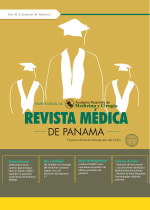Zika en Panamá y Latinoamérica: Aspectos clínicos y moleculares de una problemática emergente
Autores/as
DOI:
https://doi.org/10.37980/im.journal.rmdp.2015388Palabras clave:
Zika virus, control de vectores, brote, vigilancia, epidemiología, microcefaliaResumen
El propósito de esta revisión es presentar al equipo de salud latinoamericano y de la región del caribe un panorama de la situación actual con el virus Zika (ZIKAV), y al mismo tiempo, proveer conocimiento clínica y molecular relevante para enfrentar este problema emergente. Esperamos que esta revisión tenga un impacto positivo en el diagnóstico, vigilancia, y tratamiento de esta enfermedad viral, especialmente en comunidades endémicas, como parte de un esfuerzo colectivo para enfrentar este virus. Este manuscrito será distribuido electrónicamente y físicamente como una iniciativa de salud pública y epidemiologica.
Publicado
Número
Sección
Licencia
Derechos de autor 2016 Revista Médica de Panamá - ISSN 2412-642X

Esta obra está bajo una licencia internacional Creative Commons Atribución-NoComercial 4.0.
Derechos autoriales y de reproducibilidad. La Revista Médica de Panama es un ente académico, sin fines de lucro, que forma parte de la Academia Panameña de Medicina y Cirugía. Sus publicaciones son de tipo acceso gratuito de su contenido para uso individual y académico, sin restricción. Los derechos autoriales de cada artículo son retenidos por sus autores. Al Publicar en la Revista, el autor otorga Licencia permanente, exclusiva, e irrevocable a la Sociedad para la edición del manuscrito, y otorga a la empresa editorial, Infomedic International Licencia de uso de distribución, indexación y comercial exclusiva, permanente e irrevocable de su contenido y para la generación de productos y servicios derivados del mismo. En caso que el autor obtenga la licencia CC BY, el artículo y sus derivados son de libre acceso y distribución.






